Lumber Products and Specifications
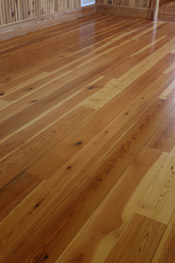
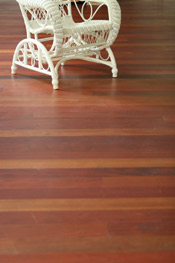
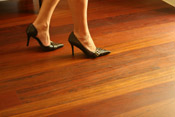
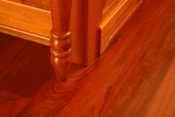
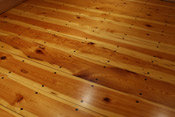
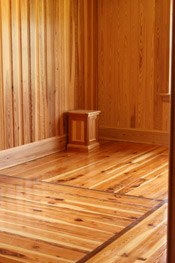
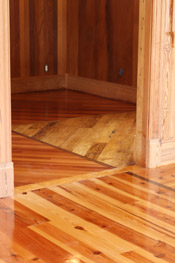
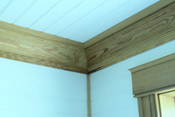
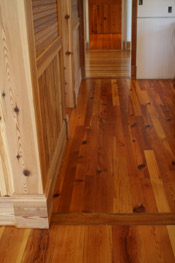
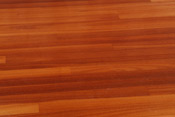
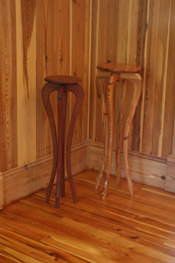
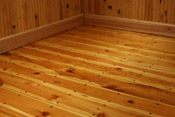
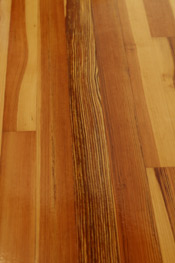
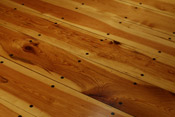
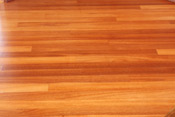
Visit our photo gallery for additional photos.
All wood is 3/4" solid and is unfinished.
Domestic
- Virgin Longleaf Heart Pine - Our Speciality!
- Antique Heart Pine - Our Speciality!
- American Cherry
- Hickory
- Walnut
- Wormy Chestnut
- Red Oak
- White Oak
- Maple
- Cypress
*Other Domestic species available upon request
Exotic
*Other Exotic species available upon request
Virgin Longleaf Heart Pine
- Widths: 1x4, 1x6, 1x8, 1x10, 1x12
- Lengths: 8', 10', 12', 14', 16'
-
- Vertical Grain - Pinstriped grain with few to no knots
- 70-100% heart pine
- Available in 1x4 only
- #1 Grade - Small-type sound knots
- 70-100% heart pine
- Available in all widths
- #2 Grade - Larger knots
- 60-100% heart pine
- Available in all widths
- Appearance
- Color - Heartwood is yellow after cutting. Because of the high resin content it turns deep pinkish tan to warm reddish brown within weeks. There are 8 to 40 growth rings per inch.
- Grain - Dense, with high figuring. Plainsawn is swirled. Rift or quartersawn is primarily pinstriped. Curly or burl grain is rare.
- Variations within Species and Grades- Moderate color variation
- Properties
- Hardness (Janka) - 1225
- Dimensional Stability - Above average
- Durability - Natural resistance to insect infestation in heartwood. Dense.
Antique Heart Pine
- Appearance
- Color - Heartwood is yellow after cutting. Because of the high resin content it turns deep pinkish tan to warm reddish brown within weeks. There are 8 to 40 growth rings per inch.
- Grain - Dense, with high figuring. Plainsawn is swirled. Rift or quartersawn is primarily pinstriped. Curly or burl grain is rare.
- Variations within Species and Grades- Moderate color variation
- Properties
- Hardness (Janka) - 1225
- Dimensional Stability - Above average
- Durability - Natural resistance to insect infestation in heartwood. Dense.
American Cherry
- Appearance
- Color - Heartwood is light to dark red. Sapwood is light brown to pale.
- Grain - Fine, frequently wavy, uniform texture
- Variations within Species and Grades - Considerable color variation
- Properties
- Hardness (Janka) - 950
- Dimensional Stability - Above average
- Durability - Strong, moderately hard
Hickory
- Appearance
- Color - Heartwood is tan or reddish. Sapwood is white to cream with fine brown lines.
- Grain - Closed with moderate definition. Rough-textured.
- Variations Within Species and Grades- Distinct differentiations in color
- Properties
- Hardness (Janka) - 1820
- Dimensional Stability - Below average
- Durability - Strength, hardness, toughness, and stiffness. Exceptionally high in shock resistance.
Walnut
- Appearance
- Color - Heartwood deep, rich dark brown to a purplish black. Sapwood is nearly white to tan.
- Grain - Typically straight and open, however some boards have curly grain.
- Variations Within Species and Grades - Huge variety of color and figure within species and grades.
- Properties
- Hardness (Janka) - 1010
- Dimensional Stability - Excellent
- Durability - Somewhat dense, strong, good shock resistance. Not as dent-resistance as red oak.
Wormy Chestnut
- Appearance
- Color -Light to pale brown
- Grain - Tight grain. Coarse, porous texture
- Variations within Species and Grades
- Properties
- Hardness (Janka) - 1810
- Dimensional Stability -
- Durability - Good
Red Oak
- Appearance
- Color - Pieces are more reddish than white oak. Heartwood and sapwood are comparable in color with sapwood being slightly lighter.
- Grain - Open, somewhat coarser than white oak.
- Variations within Species and Grades - Large variation in color and grain, depending on the origin of the wood and corresponding differences in growing seasons.
- Properties
- Hardness (Janka) -1290 (benchmark)
- Dimensional Stability - Average
- Durability - Stiff and dense and resists wear. Has high shock resistance. It is less durable than white oak.
White Oak
- Appearance
- Color - Heartwood is light brown. Some boards may have a slight pinkish tint or a slight grayish cast. Sapwood is white to cream.
- Grain - Open. It has longer rays than red oak.
- Variations within Species and Grades - Significant variation in color and grain texture, however not as distinct as in red oak.
- Properties
- Hardness (Janka) - 1360
- Dimensional Stability - Average
- Durability - More durable than red oak. Protected from fungi and insects by the tannic acid in the wood.
Maple
- Appearance
- Color - Heartwood is creamy white to light reddish brown. Sapwood is pale to creamy white.
- Grain - Closed, subdued grain with medium figuring and uniform texture.
- Variations within Species and Grades - Black maple is hard. Other species are classified as soft.
- Properties
- Hardness (Janka) - 1450
- Dimensional Stability - Average
- Durability - Dense, strong, tough, stiff, and excellent shock resistance
Cypress
- Appearance
- Color - Light yellow to light brown
- Grain - Straight, tight grain
- Variations within Species and Grades -
- Properties
- Hardness - 510
- Dimensional Stability -
- Durability - Good
Mahogany
- Appearance
- Color - Dark reddish brown
- Grain - Striped figuring in quartersawn selections. Its texture is fine and even.
- Variations within Species and Grades - Moderate color variation
- Properties
- Hardness (Janka) - 2200
- Dimensional Stability - Above average
- Durability - Excellent
Brazilian Cherry
- Appearance
- Color - Sapwood is gray-white. Heartwood is salmon red to orange-brown when fresh. It becomes russet or reddish brown when seasoned. It is often marked with dark streaks.
- Grain - Mostly interlocked. Medium to rather coarse texture.
- Variations within Species and Grades - Moderate to high color variation
- Properties
- Hardness (Janka) - 2350
- Dimensional Stability - Average
- Durability - Dense and very strong
Cumuru
- Appearance
- Color - Light brown or yellow-brown after exposure
- Grain - Fine texture, interlocked, waxy or oily feel
- Variations within Species and Grades - Dramatic shading that mellows as the floor matures
- Properties
- Hardness (Janka) - 3540
- Dimensional Stability - Average
- Durability - Good
Ipe
- Appearance
- Color -Varies from light yellowish tan with green overtones to almost blackish brown. Color will darken over time to medium to dark brown.
- Grain - Fine to medium, straight to very irregular.
- Variations within Species and Grades -
- Properties
- Hardness (Janka) - 3680
- Dimensional Stability - Average
- Durability - Very durable
Teak
- Appearance
- Color - Heartwood varies from yellow-brown to dark golden brown. If exposed to sunlight it will turn a rich brown. Sapwood is a lighter cream color.
- Grain - Straight. Coarse with uneven texture.
- Variations within Color and Grades - Moderate to high color variation
- Properties
- Hardness (Janka) - 1000
- Dimensional Stability - Excellent
- Durability - Similar to American oak
Spanish Cedar
- Appearance
- Color - Pinkish to reddish brown
- Grain - Straight, tight grain
- Variations within Species and Grades -
- Properties
- Hardness (Janka) -
- Dimensional Stability -
- Durability - Fair